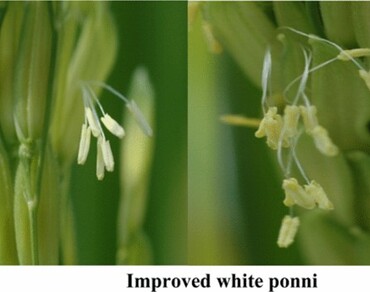Marker assisted backcross analysis for high temperature tolerance in rice
Research Articles | Published: 02 September, 2023
First Page: 731
Last Page: 737
Views: 3183
Keywords: Rice, High temperature tolerance, Recurrent parent genome (RPG) recovery, Background selection
Abstract
Breeding for high temperature tolerant genotypes and varieties in rice may be the solution for sustainable agriculture production in India. In future, the rice production, productivity and cropping season will be significantly decreasing due to high temperature (38 to 40 °C). Heat tolerance at flowering stage of rice is controlled by many Quantitative Trait Locus (QTLs) with small effects. Heat tolerant genotypes can be obtained through introgression of validated high temperature tolerance QTLs from high temperature tolarence genotypes of Nagina 22 (N22). Keeping this in view, the present study was undertaken to introgress two spikelet fertility QTLs viz., qHTSF1.1 and qHTSF4.1 from Nagina 22 (N22) into Improved White Ponni (IWP), a rainfed lowland rice variety. Heat tolerance in rice at flowering stage QTL qHTSF1.1 and qHTSF4.1 were identified as an important source for enhancing spikelet fertility. In BC1F2 {(IWP × (IWP × N22)} population, the maximum recovery of recurrent parent genome (RPG) was recorded to be 79.29% in the plant no. 6-25-29 introgressed with qHTSF1.1. Similarly, plant no. 7-46-18 harbouring qHTSF4.1 also recorded a RPG recovery of 79.04%. There was positive correlation between the yield in BC1F3 and RPG recovery (%) in BC1F2. As the RPG is 79%, more backcross generations with more numbers of markers may be attempted to utilizefine mapping of these QTL regions.

References
Allard RW (1999) Principles of plant breeding. Willey, New York
Benbouza H, Jacquemin JM, Baudoin JP, Mergeai G (2006) Optimization of a reliable, fast cheap and sensitive silver staining method to detect SSR markers in polyacrylamide gels. Biotechnol Agron Soc Environ 10:77–81
Challa V, Kole PC (2019) Parental evaluation and polymorphism survey of drought contrasting donor and recurrent parents in rice (Oryza sativa L.) using microsatellite markers. Electron J Plant Breed 10(2):406–412
Charcosset A (1997) Marker-assisted introgression of quantitative trait loci. J Genetics 147:1469–1485
Divya B, Robin S, Rabindran R, Senthil S, Raveendran M, John Joel A (2014) Marker assisted backcross breeding approach to improve blast resistance in Indian rice (Oryza sativa) variety ADT43. Euphytica 200:61–77
Francia E, Tacconi G, Crosatti C, Barabaschi D, Bulgarelli D, Aglio ED, Vale G (2005) Marker assisted selection in crop plants. Plant Cell Tissue Organ Cult 82:317–342
Frisch M, Bohn M, Melchinge AA (1999) Minimum sample size and optimal positioning of flanking markers in marker-assisted backcrossing for transfer of a target gene. Crop Sci 39:967–975
Hasan MM, Rafii MY, Ismail R, Mohd M, Mahmood HA, Rahim AS, Ashkani MMA, Latif MA (2015) Marker-assisted backcrossing: a useful method for rice improvement. Biotechnol Biotechnol Equip 29(2):237–254
Hoisington DA, Khairallah M, Gonzalez D (1994) Laboratory Protocols: CIMMYT Applied Molecular genetics Laboratory. Second Edition, Mexico, D.F. Mexico.
Hospital F (2003) Marker-assisted breeding. In: Newbury HJ (ed) Plant molecular breeding. Blackwell Publishing, Oxford, pp 30–59
Hospital F (2005) Selection in backcross programmes. Philos Trans Biol Sci 360:1503–1511
Jagadish S (2010) Physiological and proteomic approaches to address heat tolerance during anthesis in rice (Oryza sativa). J Exp Bot 61(1):143–156
Ralph VB (2008) Versatile software for visualization and analysis of genetic data. J Hered 99(2):232–236
Ribaut JM, Hoisington D (1998) Marker-assisted selection: new tools and strategies. Trends Plant Sci 3:236–239
Salina E, Dobrovolskaya O, Efremova T, Leonova I, Rouder M (2003) Microsatellite monitoring of recombination around the Vrn-B1 locus of wheat during early backcross breeding. Plant Breed 122:116–119
Visscher PM, Haley CS, Thompson R (1996) Marker-assisted introgression in backcross breeding programs. Genetics 144:1923–1932
Waghmare SG, Sindhumole P, Mathew D, Shylaja MR, Francies RM, Abida PS, Narayanankutty MC (2020) Identification of QTL linked to heat tolerance in rice (Oryza sativa L.) using SSR markers through bulked segregant analysis. Electron J Plant Breed 12(1):46–53
Weeden N, Muehlbauer F, Ladizinsky G (1992) Extensive conservation of linkage relationships between pea and lentil genetic maps. J Hered 83:123–129
Author Information
SRM Institute of Science and Technology, Chengalpattu, India